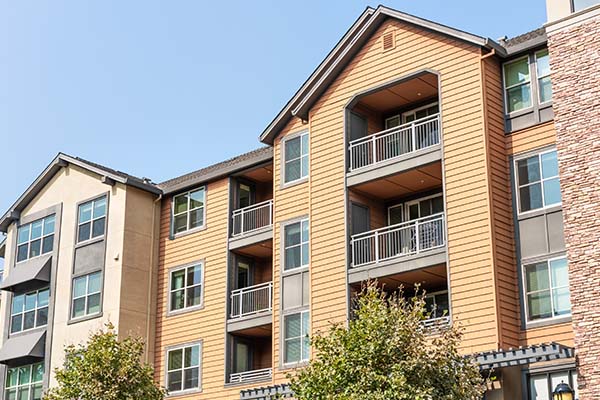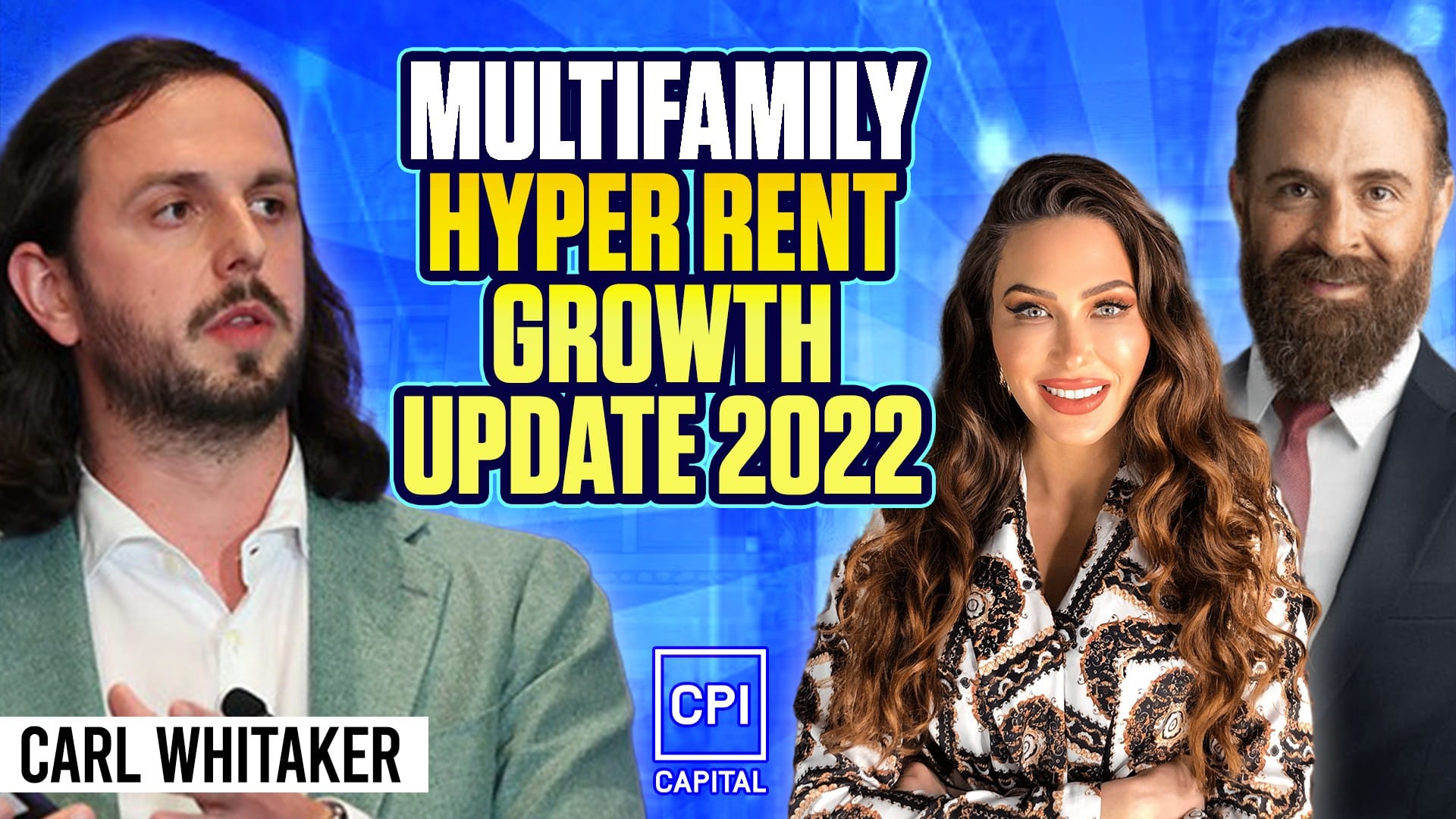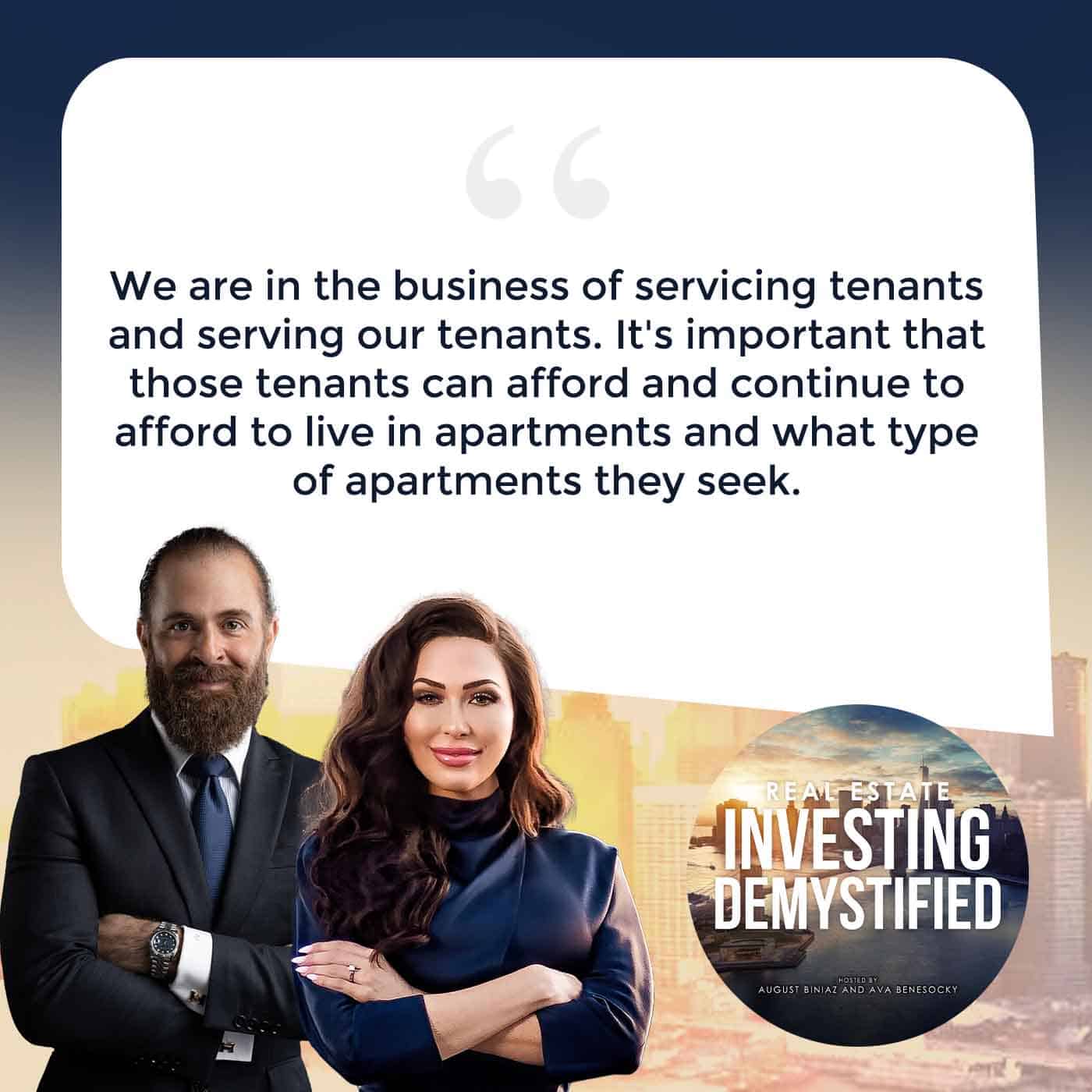In 2021, everyone saw a huge increase in rents. This hyper rent growth came along also with renter income growth. This could be because of many things such as the pandemic or interstate migrations. Could this trend continue past this year or will it end because of rising interest rates? Join Ava Benesocky and August Biniaz as they talk to Carl Whitaker about the latest trends and data in multifamily rent growth. Carl Whitaker is the Director of Research & Analysis at RealPage, Inc. Find out why the multifamily hyper rent growth is happening. Learn more about the correlation between interest rates and rent. Discover whether or not rising interest rates will discourage buyers and sellers. Listen so that you know what to expect in the upcoming years in multifamily real estate.
Get in touch with Carl Whitaker:
LinkedIn: https://www.linkedin.com/in/carlwhitaker15/
Website: www.realpage.com/analytics, www.realpage.com/webcasts
If you are interested in learning more about passively investing in multifamily and Build-to-Rent properties, click here to schedule a call with the CPI Capital Team or contact us at info@cpicapital.ca. If you like to Co-Syndicate and close on larger deal as a General Partner click here. You can read more about CPI Capital at https://www.cpicapital.ca. #avabenesocky #augustbiniaz #cpicapital
—
Watch the Episode here
Listen to the podcast here
Important Links
- RealPage Inc
- LinkedIn – Carl Whitaker
- Axiom Metrics
- The Great Gatsby
- Animal Farm
- RealPage.com/analytics
- RealPage.com/webcasts
About Carl Whitaker

Multifamily Hyper Rent Growth Update 2022 – Carl Whitaker
I’m joined by my amazing co-host August Biniaz. We have an exciting interview for you. If you can please like and subscribe, it helps us build our channel and allows us to keep bringing you great content, great experts, and guest speakers. We try to bring as much value as we can to you.
You are going to be particularly excited if you like data, numbers, growth metrics, and all of this because our guest is truly the master of his craft when it comes to these things. Also, when it comes to data and all the other great stuff here. We can’t wait to explore rent growth, population growth, and how it affects our yield.
We are joined by the guru himself. His name is Carl Whitaker. A little bit about Carl. He is the Director of Research and Analysis for RealPage Inc, where he blends in his passions for geography, economics, and teaching to foster a practical applied understanding of apartment trends and forecast expectations. Prior to joining RealPage, Carl worked as a consultant with Catalyst Commercial, an economic consulting firm based in Dallas.
Carl received a Bachelor’s degree in Secondary Education and a Master’s degree in Applied Geography from the University of North Texas. August and I believe that this interview with Carl will bring value to both passive and active investors looking to learn about the 2022 multifamily rent growth and if this trend is poised to continue. Welcome, Carl. Thank you so much for being here with us.
Thank you all for having me. I appreciate it. I have to say that it’s easy to do well in this role when the data helps you look good. I appreciate you all for having us on. I’m excited to talk about some trends here.
It’s better not, though, because every time you post on LinkedIn, I can’t wait to get on there and read what you say. You also back it up by reasoning about the data that you share. I’m excited to have you on.
We learn a lot from you. Start off by please talking to us about your background and then your start in real estate.
I will try to keep it pretty short. I’m happy to dive in more if I need to. My intro to real estate was pretty similar to a lot of people’s. I didn’t necessarily intend to end up here but the path of life took me down this route. As you mentioned, Ava, my Master’s degree is in Geography, which has a little bit of overlap with real estate. Broadly speaking, there are some nuances there but I started working with Catalyst Commercial. That was a blend of economics and city planning.
Let’s say a city has a shopping center that they are trying to reposition, what type of retailer do you bring in and why? What makes sense based on local demographics? Are you comfortable underwriting this cap rate if it’s this entity that comes in? Funny enough, we were a client of Axiom Metrics at the time for the apartment data.
As part of these comprehensive city studies, we look at the best and highest use of individual sites within cities. If it’s 20 vacant acres, does it make sense to build single-family, multifamily, office, retail, etc.? Through proxy of acquisition, I ended up coming to RealPage. That’s how I ended up here and real estate and, more specifically, in real estate data.
Talking about RealPage, we are looking to switch investor portals and get their RealPage IMS. We are excited about that.
Multifamily is starting to make up a bigger and bigger share of the overall pie of commercial real estate. Click To TweetBefore getting into the market rent trends, could you educate us and our audience about how data is collected to prepare the RealPage reports?
There are a few different ways that we collect our data, and there are two distinct data sets. It’s good that we are touching on this upfront because it is an important distinction. We have part of our data coming from our market analytics platform that is collected through traditional market surveys by calling individual properties and asking, “What is your rent on your available 500 square foot, 1 bedroom? What’s your current occupancy rate? Are you running any specials?”
That’s going to be the traditional market survey-based research. We also have, through a proxy, a lot of the products that RealPage is providing. We are able to tap into roughly fourteen million individual lease transactions. Meaning that we are able to see behind the scenes on actual rent roll data. This data gets anonymized before it’s aggregated.
We are not able to see individual lease transactions but through a proxy of using that data, we can say, “The new lease trade out at this individual property was 15% year-over-year based on a same-store set of parameters.” That’s going to be the lease transaction database. That’s a little bit more new age-y, if you will, so we do use these datasets complementary to one another.
There are 44 million apartment buildings or communities in the US. Twenty million of them are being professionally managed, so to get the data, there needs to be a lot of legwork for you to provide us as investors and consumers with such great information.
Carl, we wanted to discuss the 2022 rent growth but first, maybe we can start with 2021. As the pandemic forced the Fed to bring the interest rates near to zero, it pretty much created free debt. The markets went hyperbolic then. Can you give us a storyline on what happened with the rent starting in 2021? Did the trend continue into 2022?
I will go back a year further to 2020 to help contextualize 2019. What we saw in the initial downturn was that there was this pretty heavy bifurcation in rent growth where you had the high-profile coastal gateway markets. You are San Franciscos, and New Yorks of the world garnered a lot of media attention but if you looked at markets across the Sunbelt, stretching from Phoenix, we are talking about Phoenix in our discussion. I feel that Phoenix, the Texas markets, many of the Florida markets, Nashville, etc., those metros performed pretty well in the grand scheme of things.
You had a third subset of markets there in the nation’s Midwest. Chicago was a little bit different but Cincinnati, Columbus, Ohio, etc., were your slow and stable markets. They remained pretty slow and stable. 2020 was a year of heavy bifurcation. What we saw in 2021 was, as you pointed out, almost hyperbolic in your increase in rents. What we also noticed was that it was about that same time that renter incomes were also beginning to grow at a rapid rate. In some of the materials that are provided here, slide twelve shows renter income growth as well.
What you will notice is that in 2021, this was captured through RealPage’s lease transaction data set, and it’s looking at the average reported income on newly signed lease agreements. About that same time, those numbers started to increase rapidly, and that showed some of the external economic tailwinds that were happening.
By tailwinds, you are seeing stronger wage growth, particularly in that professionally managed apartment-style renter. Oftentimes, these are college-educated folks starting out in their career or advancing in their careers, so there was some significant wage growth happening overall. 2021 was a year where rent growth was pretty substantial but you are also seeing substantial income growth as well.
It’s important to note those in conjunction with one another because, in our view, we are not necessarily seeing too many affordability challenges, at least, broad-base. That’s not to say that there aren’t individual anecdotes where that’s the case. We want to be cognizant of that and mindful of those challenges but by and large, you are seeing similar growth of incomes to what is happening with rental rates as well. All this to say that 2021 was a year of strong rent growth but it was also a year of strong accompanying income growth as well.

Rent Growth: In 2021 was an almost hyperbolic increase in rents. But not only that, it was about that same time that renter incomes were also beginning to grow at a rapid rate.
What’s the next question, August?
We are multifamily investors. Our focus is on multifamily, and the rent growth in 2021 was 20% nationwide. Is that 20% residential or multifamily? Is that all commercial real estate asset classes combined? What is that number?
It’s hard for me to say much about other commercial real estate sectors because RealPage is so hyper-focused on conventional market-rate multifamily but to your point, August, the numbers are pretty close there. 2021 we saw a 16% to 17% rent growth overall, so those numbers are pretty closely corroborated with what you’ve said there. From what I’ve heard, anecdotally, the industrial sector has seen similarly strong rent growth.
Office and retail may be a little bit more challenged but we have seen overall in terms of commercial real estate. I know that multifamily is making up a bigger and bigger share of the overall pie. If memory serves me correctly, 2021 was something like 42% of all commercial real estate property trades was multifamily. That was up from 30% and the previous real estate cycle. There’s lots of capital flowing into apartments that may be coming from other avenues, that is, retail offices, etc.
Within the multifamily sector, the different asset classes, do you have any data or numbers on which asset class A, B or C was the best performing when it comes to rent growth?
We do. One of the things that candidly surprised us when looking at these numbers was that it wasn’t a strength happening in one asset class that was driving up all of the numbers. It was a ubiquitous strength, where Class A occupancy was pulling up to record levels. It’s the same with rent growth. You could say the same for Class B. If there’s a slightly weaker product class, it’s going to be Class C. The occupancy numbers look a little bit stronger but what I would note there is that Class C business, oftentimes, tends to be a bit more of a cashflow business.
If you look at rent growth for that product class, especially on lease renewals, they are growing at about the same rate that the CPI or the inflation rate is, so Class C is probably a little bit softer and maybe being masked by some of the overall economic tides that are lifting, for lack of a better term. The surprise for us was how well Class A has responded, particularly considering we are seeing record construction levels.
On to the next topic, I wanted to discuss interstate migration with you. It’s this great migration of people moving from California and New York to the Sunbelt. We assume this is added to the rent growth in these markets but do you have any data or evidence that shows the migration will continue? We were talking to a partner of ours, and he mentioned that Texas is expecting about a million in migration over the next couple of years.
I can see if I can check on some of that data, and I happen to be based out of Texas, so I can at least offer some boots-on-the-ground insight there. Broadly speaking, the way we are looking at some of the migratory flows over the past few years is that COVID accelerated some trends that were already happening. You are already starting to see California with the population growth slowing. It wasn’t declining, and the past years have been different in that regard but growth was concentrated more along the Sunbelt states in a lot of ways. COVID accelerated that trend.
Something that struck us fascinating in the migration data here as of late is if you look at resident retention rates or the percentage of residents who are electing to renew their lease, you are not necessarily seeing a big move back to places like California or New York. In other words, if somebody moved to Florida years ago, it doesn’t appear that there are a lot of people moving back to their original home markets. It’s not to say that it’s not happening in some instances but, at this point, it looks like most of the migratory inflow has been more or less solidified.
Having said that, the pace of growth out of California into Utah, Idaho or Arizona that’s going to start to slow down now that some of the measures that made California attractive, to begin with, high quality of life, close proximity to high-quality employers that are in the Bay Area, for instance. Those things are starting to normalize, so the pace of migratory flows is going to start to rebalance here in the near term. Some of the trends that we saw over the past years were already in place but it’s just that COVID accelerated them.
Multifamily will see less susceptibility to pressure coming from affordability challenges right now. Click To TweetA quick question for you that comes up. Here in Canada, we are a nation of immigrants. Every year historically, we would bring in 300,000 immigrants. The government immigration mandate is now 1.3 million over the next few years of immigrants. Most of those immigrants want to live in Toronto, Vancouver, and large cities.
The demand is going to go through the roof. Most of the time, I don’t hear the US talking about immigration but the US is even more of an immigrant nation than Canada. Is there any research on actual immigration to the US coming from South America, Central America, and other places around the world and how that affects real estate?
It has been a little bit hard for me to get my hands directly on some of that data but the data that I have seen suggests that migration coming from the Central American states, particularly Mexico, has been suppressed over the past years. Interestingly enough, we are seeing some of those states like Arizona and Texas that were destination spots for many of those migratory inflows have slowed on the international migration side but they’ve picked up on the domestic migration side. The overall numbers were washed out to look more or less like, “Migration happened,” but it wasn’t from the international side.
If you extend that a little bit further to the nation’s West Coast markets, for instance, one of the things we saw happen with student housing, in particular. Many of those areas, the University of Washington, Cal, Berkeley, UCLA, and those real big marquee brand name universities on the West Coast, have essentially missed out on years’ worth of exchange students coming from the Asian states.
We are seeing that also happen on the conventional marketplace side where you are not seeing as much migration happening from those parts of the world, whether or not that continues, that’s going to be a tricky crystal ball-type scenario that maybe takes a little bit of time to see how that shakes out. It’s a fascinating question because the components of migration are oftentimes as important as the overall migration numbers.
Especially when you have China and India, two of the world’s most populated countries, and a lot of times, on the professional side, brain drain that happens from China and India into the US into California for all their tech stuff. A lot of times, people are from that demographic but also, India is having one of the world’s largest middle-class now, with over 300 million.
China, with the economic boom, a lot of time looking for the West to buy a home for their children to go to school as it happened. We live in the city. Richmond is a suburb of Vancouver, and it’s over 70% Chinese population with a city of 200,000 people. Ava has never seen so many Chinese restaurants and Chinese foods. She’s like, “I thought Chinese food was sweet and sour pork.” I’m like, “No.”
They have chicken fried rice. I have one, and it’s one of the best dishes in the world. I have been missing out all my life.
They have 5,000 years of civilization. They got more dishes than the Italians and the French combined.
Sichuan is my favorite.
The spice in that is really good. Once you get true, authentic cuisine like that, it’s hard to go back to the standard stuff.

Rent Growth: COVID accelerated migratory flows over the past year. California was already starting to see population growth slowing. The growth is more concentrated along the Sunbelt states because of COVID.
Nothing beats it. You are not living life until you get to taste some of that kind of food.
Let’s talk about affordability. It’s an important topic because here at CPI, and we serve our tenants. We are in the business of servicing tenants and serving our tenants, so it’s important that those tenants can afford and continue to afford to live in apartments and what type of apartments they seek but 70% of the American population can afford to buy a home. In most cases, this means people renting apartments.
With the rents continuing to grow as we’ve had this conversation in our meeting, where’s the peak? Where is the tipping point? We know that wages are also increasing but none of the rents are growing. What’s going to give first? Is there going to be a balance coming down the pipe here? Give us your thesis on this.
With multifamily, we are probably going to see less susceptibility to pressure coming from affordability challenges. What I mean by that is, if you look at the single-family side, there’s a heavy supply imbalance as opposed to a demand imbalance. On the multifamily side, there are certainly some supply constraints. If you look at a longer-term graph for permitting, and as a matter of fact, some of the drivers that have caused some of the single-family home appreciation in particular in recent years, there’s a huge under-supply of housing.
In fact, only here in the past few months have we got back to pre-Great Recession levels of permitting. That’s that blue line right there. You can see that in February 2022, about 800,000 single-family homes were permitted. That’s the most that have been permitted since 2007, and they are basically getting back to the 1990s-decade norm. We’ve seen this huge undersupply of single-family housing, in particular, has constrained the market affordability there.
Conventional multifamily housing, and now keep in mind, this is looking mainly at professionally managed and owned properties. I do hesitate to paint with too broad of a brush and look at some of the non-professionally managed properties but affordability challenges haven’t been quite as significant, nor have they been quite as supply-constrained. It’s because those multifamily assets have been building at a more stable, healthy pace. Now you are still seeing some shortage of housing but it’s less so on the multifamily side and more so on the single-family side.
Let’s discuss the increasing interest rate environment in which we are. What is the correlation between interest rates and rents?
In the correlation, there’s probably not quite as clean as it is on the acquisition side or the capital market side. I’m sure I’m preaching to the choir here in some ways. As interest rates have increased, it has been harder to secure some deals in some ways. Going back to the last point on single-family housing, as we see these interest rates continue to rise, we are going to see fewer buyers of homes in addition to fewer people willing to sell their homes.
They are confronted with the same issue that the buyers are of, “There’s already limited availability of housing, plus my mortgage rate is going to increase versus what I currently have locked in.” It’s a bit of a catch-22 in some ways, and thankfully, there are smarter people out there than me that have to figure out this broad-based issue of rising interest rates and how that impacts the economy.
Going back to the question here more specifically, it’s a bit harder to draw a clean correlation between rising interest rates or falling interest rates and the price of rental appreciation than it is looking at single-family home price appreciation. If there is one area that maybe you see some level of additional correlation, it would be Class A rent growth in some of these markets, where historically, you may be at risk of losing a renter to a single-family home purchase, based on the difference between a Class A rent and what a mortgage rate would be.
I will share an anecdote. I purchased a house here in McKinney, Texas, which is one of the Northern Dallas suburbs, in 2020. My rent, at the time, was about $1,450 per month. The mortgage that I ended up securing was about $1,600 per month. A few years ago, you had that scenario of where someone may be already looking to buy and is almost incentivized to purchase if that rental rate got too top-heavy and pushed them towards single-family housing.
If interest rates continue to rise, there are going to be fewer buyers and fewer people willing to sell their homes. Click To TweetNow, and maybe I’m looking through much of a Dallas-focused lens, here, it’s almost impossible to find a home in these Northern counties for under $400,000. Even Class A rents are at a level that isn’t tipping residents into the single-family for purchase buyer pool. Maybe that’s where the interest rates do have a little bit stronger of a correlation. Rising interest rates could translate to slightly stronger Class A fundamentals. That’s what I would use as a quick summary sentence.
With interest rates on the rise for the first time in almost decades, investors are wondering if cap rates are going to follow the suit. Do rising interest rates always mean rising cap rates and consequently lower values?
It’s hard to say because you never want to say that it always translates 1 to 1. At least on the multifamily side that I’ve seen thus far, the rising interest rates haven’t necessarily discouraged buyers but how much are sellers willing to budge from their expectations to meet that of the buyer? What I have been hearing anecdotally is that we talked to a lot of investment capital groups where they’ve still got the appetite to acquire.
August, you mentioned earlier that Phoenix as a cap rate and the little 4% range was crazy to think about, certainly more than ten years ago. The buyers are still looking at a market like that as a favorable investment vehicle based on performance fundamentals over the next few years but I don’t know how much we’ve seen seller expectations adjust to rising interest rates.
A 1% increase in an interest rate influences the buyer’s underwriting. It doesn’t necessarily influence what the seller wants to achieve on their exit. There’s still maybe a mismatch, and it will take some time to balance what those buyer and seller expectations are but we will find that equilibrium at some point. Thankfully, it’s smarter folks than me who get to figure out what that equilibrium is.
Hopefully, as all this liquidity and capital from different asset classes that poured into multifamily over the last couple of years go back into hospitality, retail, and office space, it will lower the demand here a little bit. Make it a bit more of a reality check for the sellers of multifamily projects. We know how that works because we’ve seen it happen here in Canada a lot. The certain demographic that own properties are so reliant on what their property is appraised that they are not budging but it’s interesting to see that.
Interesting question on cap rates. I want to bring a comparison and talk about comparing Canada, particularly Vancouver and Toronto, to Los Angeles and New York. We talk about cap rates being around 2% to 2.5% in most of these large cities where people want to be, and the reason for that is a risk. If you buy something in New York, Los Angeles, Vancouver or Toronto, the likeliness of the property, the natural market appreciation continuing is very high, and the demand is going to be very high.
That’s why the cap rates are low but as we see with places like Phoenix, the cap rates keep compressing. It’s like what we’ve discussed before the show started and as you’ve alluded to. We see that the cap rates are compressing so much. Is this a trend that we are going to see continuously happening in these up-and-coming regions and cities? Are all roads going to end up in Rome? Is it going to be a trend that’s going to continue everywhere where cap rates get so compressed that it no longer makes sense for our business model?
For example, CPI Capital can acquire multifamily assets in Vancouver or most places in Canada because it doesn’t have the cashflow and the appreciation, and then we do force appreciation. That’s why we are in the Sunbelt states. If the Sunbelts are turning into Vancouver, then we might be out of business. Tell us about your prediction. How do you see this happening because it’s a trend that’s continued for so long now, the cap rate compression?
I find it fascinating hearing Canada versus US comparisons too, because even though they are culturally similar in a lot of ways, there are some pretty stark differences between the Canadian real estate market. As you pointed out, there are half a dozen Metros that have big-time investor interest, and then the drop-off after that it’s pretty steep. I have a friend who is from Thunder Bay, and I’m not sure how much investment capital Thunder Bay is pulling in versus Toronto or Vancouver.
Here in the States, it’s a little bit different where, historically, maybe Nashville or Charlotte was like, “It’s the second tier. Maybe we will look at it. Probably not,” but now, based on how some of those markets and states have grown, not only do the demographics and the economic growth suggest that those are viable investment targets.

Rent Growth: In multifamily, the rising interest rates haven’t necessarily discouraged buyers. It’s more about how much sellers are willing to budge from their expectations to meet that of the buyer.
To your point, if you look at that cap rate compression in San Francisco, not to mention the price per unit in San Francisco versus that of a Phoenix or a Salt Lake City, it is almost incentivizing some investment groups or capital groups to start looking at the Sunbelt with more earnest. As far as that cap rate compression and can it continue, it’s hard to see a scenario in which they continue to compress at the rate that they have over the past few years at this point. There could be some further contraction that happens but I don’t necessarily see it happening at the rate that it has here.
Interestingly enough, if you look at some markets in the Midwest, in particular, thinking about Columbus, Detroit, etc., those areas hadn’t seen as much investor interest but those markets have cap rates in the mid to upper 5% range. There’s still yield to be achieved out there in some markets. Where you run into some headwinds is how much liquidity you have in Milwaukee or Columbus versus how much liquidity you have in Miami.
Whereas Miami maybe historically was a mid-5% cap, and now it’s a low 4% cap. I don’t know that it will necessarily see Miami get to a 2% cap but that market could go down to 3.5% to 4% more quickly, and it will start to uncompress but I could see those numbers maintaining where they are at for some time until some fundamental shift comes in.
I wonder if there’s a tipping point for a city that when it gets to a certain GDP or a certain population, it tips that point where the interest rate and cap rate spread becomes inverted or at par. I wonder where that takes place because we can see it happening in a lot of different cities but it’s interesting to follow this trend.
We would like to discuss multifamily ground-up developments. We’ve known this for a while. Since 2008, there has been a lag between demand and supply. Do you have any data on this? Are you seeing developers taking the plunge and getting back into the market?
To your point, Ava, there was that point back in the Great Recession where permitting activity dropped pretty substantially. It took a little bit to recover. It didn’t take as long for multifamily permitting to recover as single-family permits. The reason I bring that up is if you look at the past year, there was barely a hiccup on the multifamily permitting side.
From all the data that we’ve seen and the conversations we’ve had, that hiccup, let’s call it February 2021-ish, was less due to developer appetite and was more due to administrative. It was hard to get these things pushed through because there weren’t enough people working in an office to get it pushed through. That’s whenever we were all trying to figure out how to get our hands on the situation. With this being a trailing twelve-month number, that’s going to lag about a year, so that’s when you start seeing that brief dip.
The reason I point that out is if you look at nowadays permitting activity, it’s at a record level for multifamily permits. Developers have already taken the plunge there. In a lot of ways, they are looking more closely at markets in the Sunbelt and a little bit less in some of those coastal gateway markets. Not only from a performance expectation perspective but it’s a lot harder to get a deal to pencil out in Manhattan now than it was years ago and certainly more so than historically.
You are seeing developers take the plunge. I don’t know that we will get too much into it in this conversation but what’s interesting is to see how much of the permitting activity is showing up as single-family but it’s single-family for rental housing. We are seeing a big trend of build-to-rent, and there has been a lot of permitting activity centered around that here lately.
Being here in Dallas, I see it all around where there are big communities that are single-family built-to-rent popping up left and right, it seems. If there’s a trend that we want to watch in the near term, it’s going to be how much of this permitting activity essentially functions as multifamily but is technically single-family by nature of how that build works.
I’m going to come out and say that even as a multifamily investor, I am the most bullish on build-to-rent single-family because when you do it, you can do it in segments. In building a multifamily structure, you can say, “Build a little bit of it and then rent it out.” Have some cashflow coming in while you build the next phases. Whereas single-family could build ten, rent those out, and move to the next one so you can build big communities.
It's a lot harder to get a deal to pencil out in Manhattan today than it was 10 years ago. Click To TweetIf things change, you can sell each single-family individually by itself. You can’t do that in multifamily. It’s because of the compressed cap rates here in Vancouver, there was a trend where a lot of apartments turned into condos. It was called condo conversions, and that caused a big issue here with supply. There are not enough residences for people because they have to buy but there’s not enough to rent. Final question before we move to this next segment of our show.
I’m going to steal this one because I’m excited to hear Carl’s thoughts on this one. We feel a bit a little bit bad about asking this next question because we are going to be putting you under the gun. You are so immersed in the market. What is your prediction for 2023 as far as the highest performing rent growth cities in the US?
It’s certainly putting me under the gun because this is what we deal with day-to-day. We are still probably most bullish on many of the Florida markets. Many of what we have been calling here lately are the mountain and desert markets, so Salt Lake City and Phoenix markets. It’s essentially markets that are adjacent to California and Washington, those areas that saw a lot of move-outs during 2020.
If there’s an area that maybe has some additional upside, it could be some of these gateway markets that are simply based on the timing of their recovery could have some additional upside over the next months. I liken it to a rubber band. Those markets pulled back so far that whenever that rubber band is let go, they are going to see large rebounds subsequently, and that’s the nature of a high beta market. Some of those markets could have some upside potential. There are some more extraneous factors working against many of those markets, that is rent control.
If you look at Los Angeles, for instance, that market could certainly support stronger renewal rent growth than 8% simply based on demand fundamentals but that gets capped by local legislation. That could be an Achilles heel for some of those markets. Not to say that performance will be weak based on that but I don’t know that they will necessarily hit their full potential based on that upside. Conversely, one of the reasons we are so bullish on Phoenix and some of those Florida markets is that if you look at the difference between the rental rate a resident is paying now versus what a new lease resident would be paying, the gap between those rates in some instances is as big as 20%.
Even if renewal rents grew 15% for a resident that stayed in place and a new lease resident saw 0% rent growth, that resident electing to stay in place is still getting a better economic bargain based on that gap or that loss to lease. Florida lost lease numbers are so drastic. As a matter of fact, now that I think about it, one of the slides in the deck, slide 26, is going to be, at least in my view, a pretty good reading left to right. Those markets on the left are probably our near-term favorites for rent growth.
As you work to the right are going to be markets that maybe have a little bit more limited upside, it’s not quite a 1-to-1 comparison because I would call out Raleigh-Durham there as a market that we do like longer-term. That gives you a flavor of areas that are maybe more apt to see outperformance Miami, West Palm Beach, Fort Lauderdale, Tampa, Greensboro, Orlando, Phoenix, Nashville, etc.
We appreciate all the information you gave us. We are up to the next segment of our show.
It’s the Ten Championship Rounds to Financial Freedom. It’s whatever comes top of mind. I’m going to get started, and let’s have some fun. Carl, who was the most influential person in your life?
Let me give two answers. My most immediate answer is going to be family members all-around. A little bit of background. I grew up in a small town. I grew up on a farm here in Texas. They always encourage me, “You can do more than staying in this small town.” They have always been a huge inspiration and very influential. I love them dearly in any way possible. As far as a celebrity influence, I like Bob Weir, the guitarist for the Grateful Dead. I love his approach to life. It has been fascinating seeing the Grateful Dead come back into fashion with the younger generation but it’s because they have such a lasting message in so many ways.
I would have never guessed you are into music.

Rent Growth: If you look at some markets in the Midwest, in particular, those areas hadn’t seen as much investor interest, but they have cap rates in the mid to upper 5% range. So there’s still yield to be achieved out there.
What’s the number one book you’d recommend?
I have to be candid and say that I don’t read as much as I should. That’s definitely something that I should read more about.
You are analyzing data.
Your mind is consumed.
It’s funny, August, that you say music because that tends to be my vice when it comes to entertainment. I dive into music more fully, so I don’t dive into books as often but honestly, I might have to come back to that one. I have favorite books.
Are there books that you’ve heard over time that people recommend or some book that comes to mind that people talk about?
One that’s always come up for me, it has been The Great Gatsby but that’s strictly an entertaining read. Animal Farm falls in that same grouping of entertaining reads but I don’t know that it has a lot of business world applications. I wish I had a better answer for you all there.
The Great Gatsby, the same as the movie book?
Yeah. They did a pretty good job of capturing most elements of the book in the movie.
It’s one of my favorite movies.
It’s one of my favorites too. I have been bugging you to watch that. Now, we have to. Carl, if you had the opportunity to travel back in time, what advice would you give your younger self?
Don't be afraid to take risks and be authentically you. As you figure that out more things will come easier to you because it's more authentic and genuine. Click To TweetDon’t be afraid to take risks. Don’t be afraid to step out there and be authentically you. That’s something that we are always all working to become better at. As you figure that out, more things in life will come easier to you because it’s authentic and genuine.
What’s the best investment you’ve ever made?
The house that I bought in 2020, which unbeknownst to me, at the time, I was like, “I bought at the top of the market. We are about to go into a recession. It’s going to take a few years to recover.” Here in Dallas, it didn’t take long at all. This house has probably been the best investment. We talked in the pre-show that I’m now getting ready to sell it and move out. It’s definitely this house here.
What’s the worst investment you’ve ever made, and what lessons did you learn from it?
I don’t want to say my undergraduate was a bad investment because it paid dividends but I wish I would have treated my undergraduate as more of a true learning opportunity as opposed to more of a social opportunity. I was focused on school when I was in school but I wish I would have approached it more earnest, knowing now what I do. I wish I had taken more interest in Stats courses, Economics courses, and Finance courses. I don’t want to say it was a bad investment by any means. I just wish I would have treated that with more earnestness than I did at the time.
Don’t we all feel that?
This is a good one. How much did you need in the bank to retire? What’s your number?
Honestly, probably not much because I want to get back out and live in the country at some point. I want to live on quite a few acres and have a simple little farm there. I would say enough to buy 20 acres of land and continue working and have modest means after that. Let’s say $2.5 million.
Live a peaceful life.
Maybe $5 million with inflation.
If you could have dinner with someone dead or alive, who would it be?

Rent Growth: Build-to-rent houses are technically single-family but function as multifamily.
Bob Weir would definitely be on that list. Honestly, all my answers are probably going to be musicians. Funny enough, Sturgill Simpson, and Hernán Cattáneo, an Argentinian DJ. I would be fascinated to hear the perspective of all sorts of different genres and how they approach their art and their craft.
If you weren’t doing what you are doing, what would you be doing now?
In my undergraduate, I intended to become a teacher upon graduation, and then I thought, “Maybe I will go back to grad school.” In our earlier conversation, I stumbled into real estate. If I weren’t doing what I’m doing now, I would probably go back and try to get a PhD and become a professor at a school.
Book smarts or street smarts?
Probably a little bit of both. More street smarts, though. A good example is what you all do. There’s a ton of literature out there that you can comb through but at the same time, there is a gut feeling. I’m sure you all enter conversations where you are like, “I’ve got a good feeling about this person or there’s something that feels off about the deal,” or whatever it may be. Street smarts trump because it’s that intuition.
If you had $1 million cash and you had to make one investment now, what would it be?
This goes back to what we said earlier. I should already correct myself here because I said, “Take more risk,” and I’m going to answer this with a risk-averse answer. I might find a way to park it in art because I always liken it to a leadoff hitter in baseball. Art is this investment vehicle for wealthy people that appears to be like a leadoff hitter in baseball. It doesn’t hit you a lot of home runs but it doesn’t strike out either. I might find a unique piece of art that is going to hold value, and at least you’ve got the ability to look at it, use it, and have some utilization out of it as well.
It’s the first time somebody said that.
It’s a huge business.
What is the best way people can reach you if you can let everybody know?
As August mentioned, I’m pretty active on LinkedIn. Certainly, feel free to search for my name there. It will say something about RealPage. I would be happy to connect with whoever. We also have our RealPage.com/analytics site, and that’s where my team and our content team post a lot of market updates and intel there. Honestly, I don’t have any social media, so I don’t have anywhere that would be easy to reach out to other than LinkedIn or RealPage.com/webcasts, where we host a lot of our recorded sessions.
We appreciate you coming here and taking time out of your busy schedule. We are huge fans of yours and all the data that you and your group provide. Thank you.
Thank you so much, Carl, for being here.
It sounds good. Thank you all so much.





